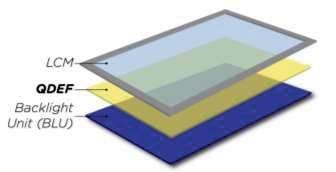For a while we have been hearing that Quantum Dot technology might be the new competitor to LCD and OLED technology with companies such as Amazon, Samsung and Asus starting to use it in their end consumer devices such as the Kindle Fire HDX tablets, SUHD Televisions or Zenbooks.
This make us wonder how is this technology different from the others and why is it seen as one of the most exciting developments in display technology for Industrial applications.
What is Quantum Dot and how does it work?
Still an emerging technology, Quantum Dot seems to be a promising alternative to OLED technology as it enhances the performance of traditional LCDs. This makes quantum dot an exciting prospect for any display product. But first what is QD and how does it work?
Quantum dots are nanoparticles between 2 and 10 nanometres in diameter which can be compared to 50 atoms or 2-10 billionth of a meter.

These dots are incorporated directly onto the backlight of the LCD. Quantum dots allow the use of blue LEDs rather than white LEDs. White LEDs are in essence blue LEDs with a yellow phosphor coating.
As a result the brightness of the displays can be up to 20% brighter than traditional LCDs: This is a promising result for outdoor industrial applications where the display needs to be visible in direct sunlight.
Removal of the yellow phosphor coating also result in lower power consumption: LCDs using quantum dots can see reductions of up to 40%. This results in much better efficiency and life expectancy of the device using this technology.
Is Quantum Dot cheaper than OLED
And cherry on the cake: we expect them to be cheaper than OLEDs! As quantum dots are an enhancement of traditional LCDs this means only slight changes to manufacturing processes Industrial applications are always highly influenced by consumer products and as we mentioned before, major companies are already adopting this technology.
Another benefit of Quantum dots is that the colour of the light emitted by these dots is directly related to its size: by changing the size of these dots it changes the wavelength of the emitting light converting it into red, orange, yellow or green. This greater level of control results in more precise colour representation with the visible spectrum increased by as much as 50%. This also results in the production of cleaner whites, which means better contrast ratio, giving us a LCD with an optical performance very similar to an OLED display.


